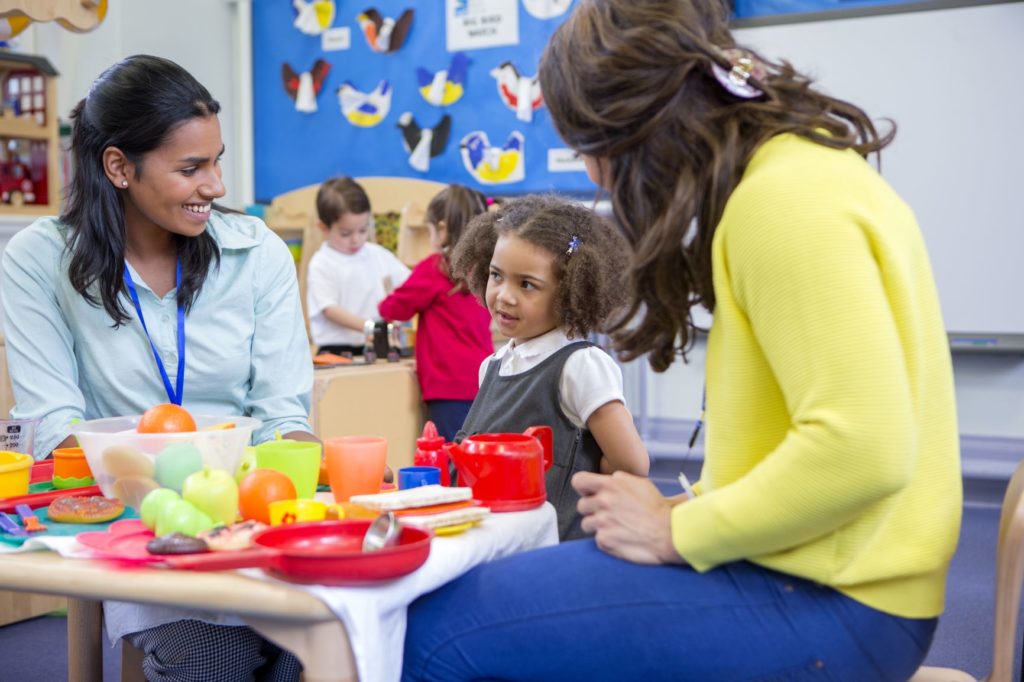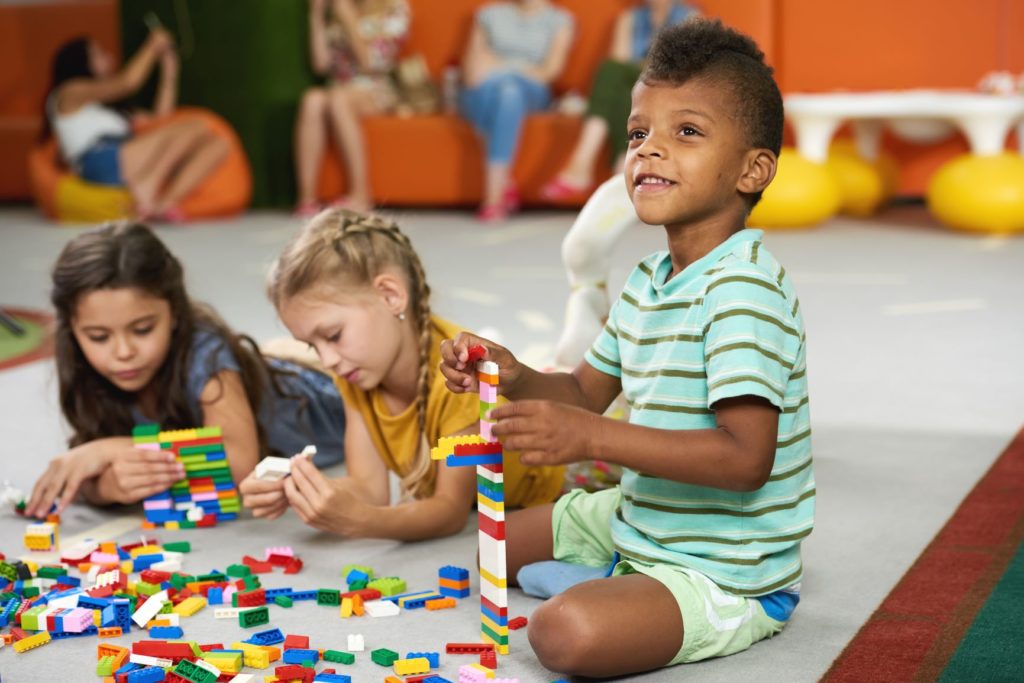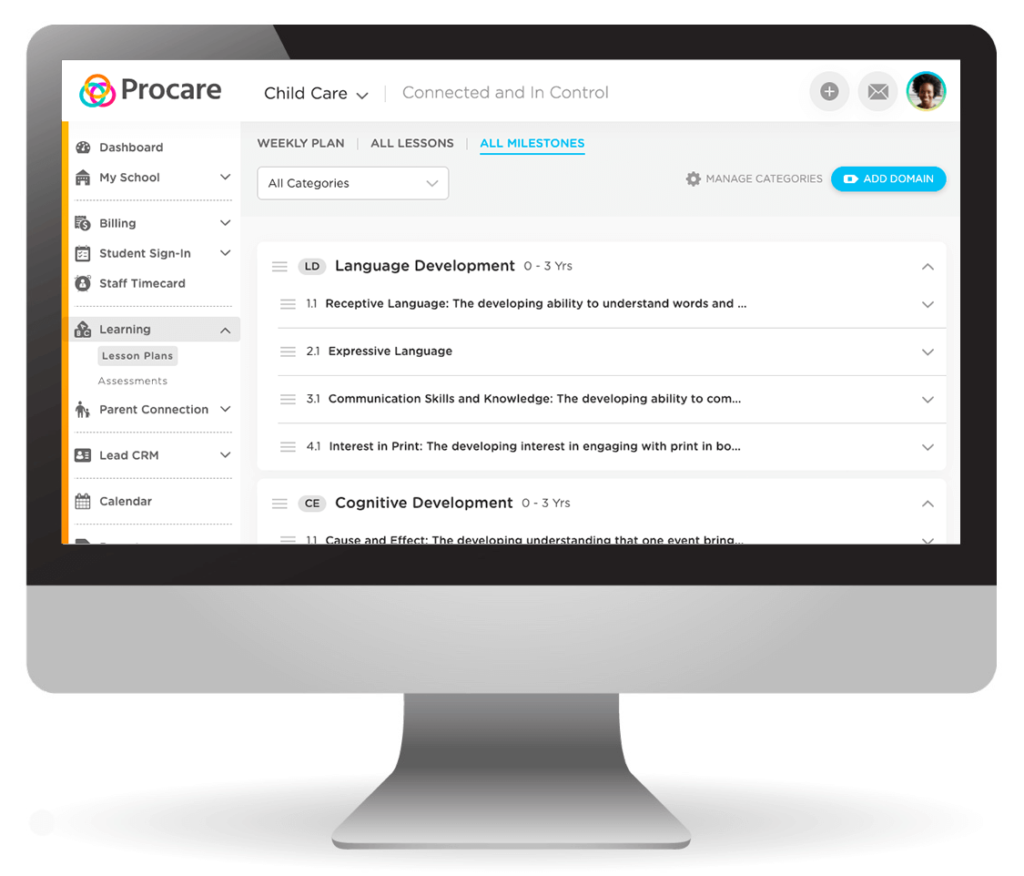
Children are driven by natural curiosity, an inner spark and an eagerness to learn. To guide children’s learning and help them reach their full potential, every child care center needs a curriculum that will support every child through their development in every learning domain.
This blog post looks at the leading child care curriculum models used by child care providers to help kids reach their full potential. We’ll also explore the connections between child care curriculum, state learning standards, and the five learning domains. Finally, we’ll talk about how child care centers can use Procare Solutions to organize their curriculum, plan lessons, and support child learning outcomes.
What is a Child Care Curriculum?
Nancy Dougherty at Early Learning Success provides an excellent definition of a curriculum: a curriculum is “goals and plans for children to acquire skills and knowledge through activities, experiences and opportunities.”
A curriculum gives form to the educational goals of your center. It covers both the goals (desired outcomes) and plans of your educational activities. Your curriculum will outline what skills and knowledge children will acquire, how they will acquire them, and how you’ll measure what they’ve learned.
There are many different philosophies of child development and education, most of which are applied to one or more curriculum models. Let’s take a closer look at some of the most popular curriculum models in use today.
What are the Leading Child Care Curriculum Models?

Bank Street Development-Interactive Approach
The Bank Street Development-Interactive approach is a widely-used whole-child-based learning program developed by Lucy Sprague Mitchell in 1916, drawing on the educational theories of John Dewey. “Interactive” refers both to the interaction of the child with the world, and the interaction between the different spheres of development.
Children’s natural interests are the starting point of this approach, which rests on observation of kids and their methods of learning. The how is considered more important than the what, as teachers build on children’s play activities to create lessons.
One unique feature of this curriculum is its affirmation of the teacher’s development as much as the students’. Teachers must become subject matter experts and continually improve their knowledge of both pedagogy and their material.
Dodge Creative Curriculum® for Preschool
The Creative Curriculum®, originated by Diane Trister Dodge in 1978, is a comprehensive curriculum with a focus on meeting objectives through discovery-based learning. As a research-based curriculum, it is under constant refinement in accordance with the latest evidence in child psychology.
Its core framework is based on five areas that contribute to children’s education:
- how children develop and learn
- what children learn
- the learning environment
- the role of the teacher
- the role of the family.
It emphasizes arrangement of the classroom into interest areas that facilitate play and discovery, and frequent assessment according to progressional learning objectives.
A key benefit of the Creative Curriculum® is that it is designed with state early learning standards in mind, making it easy for teachers to implement and monitor compliance.
The HighScope Curriculum
The genesis of the HighScope curriculum was the 1962 Perry Preschool study, an educational experiment that showed the lasting generational benefits of a routine-based curriculum on disadvantaged students. David Weikart, who directed the study, went on to found the HighScope Educational Research Foundation in 1970.
An active and project-based curriculum, the HighScope program is centered around a unique daily routine of “plan-do-review.” This routine helps kids develop the skills of strategizing, execution and critical reflection upon their achievement.
The goal is to establish an environment that is consistent and predictable, yet flexible to the needs and interests of individual children. HighScope also emphasizes the importance of parental involvement, and improving parent-child interactions in the home.
Kamii-DeVries Constructionist Perspective
Constance Kamii and Rheta DeVvries were professors of Early Childhood Education who developed an educational model based on the constructivist theories of Jean Piaget. According to this theory, children learn by actively constructing knowledge about the world within a logical-mathematical framework.
The Kamii-DeVvries perspective emphasizes physical activity and sensory engagement in learning. The classroom is laid out to allow children to select freely from various educational games and experiments. Instructors act as facilitators of the child’s active learning process, which must be self-motivated and grounded in confidence in the ability to learn.
Montessori Method
One of the oldest and best-known curriculum models, the Montessori Method was developed by Maria Montessori, the first female physician in Italy. In the early 1900s, Montessori extensively studied pedagogy and opened a classroom for young children, where she developed her methods. This model is today used by schools around the world.
The Montessori method offers children independence to learn in a structured environment. Students are given uninterrupted blocks of time to devote to self-chosen activities. There is a high emphasis on individual responsibility and self-development: classroom activities are called “work,” and children are expected to participate in tasks like tidying.
One unique aspect of Montessori’s program is her special learning materials, which are physical objects thatwhich are intended to help children explore and discover concepts like counting through active sensory engagement.
Direct Instruction Model
Unlike most of the curriculum models presented here, the Direct Instruction Model is teacher-directed rather than student-centered. It more closely resembles traditional approaches to education and is designed to offer maximum benefits from teacher-directed learning.
The Direct Instruction Model consists of step-by-step presentation of material, followed by guided practice. It uses achievement tests to measure student progress and to group kids into skill-based levels. There is a strong focus on review and repetition of previous material.
Lessons are arranged into question-and-answer sessions that allow teachers to give immediate feedback to students. Finally, students will reinforce their knowledge with independent practice.
Child Care Curriculum and the Five Learning Domains

A successful child care curriculum provides activities, experiences, and opportunities across all five learning domains. These experiences do not always take place as part of an organized lesson — they can also be incorporated into the daily routine or schedule for kids at your center. Understanding the five learning domains is critical for developing a child care curriculum that meets the diverse developmental needs of children.
A rich child-centered curriculum helps kids develop approaches to learning. Their natural curiosity is stimulated by their environment, and they are allowed to develop independence and self-management, and discover their own learning preferences. This could look like:
- Playing games that promote impulse control, such as Simon Says
- Encouraging children to participate in routines, such as dressing and tidying
- Prompting children to think of new ways to reuse materials
Their social and emotional development is fostered by positive connections among students, and between students and teachers. Activities like group projects, sports and playing together teach kids how to engage with others fairly and compassionately. Empathetic responses from teachers encourage kids to understand their own emotions and those of others.
Language and literacy is served by activities that help kids express themselves in language, recognize letters and numbers, develop their vocabulary and form the early skills of writing. This could mean activities like:
- Arranging letter blocks into words
- Naming all the sounds one letter can make or naming words that start with that letter
- Simply having a conversation where the child is encouraged to build a narrative about their experiences
A child’s cognition develops into thinking and reasoning skills throughout their life. Understanding relationships like larger and smaller, cause and effect or opposites is the foundation of adult-level reasoning. Kids can develop important reasoning and problem-solving abilities by engaging in activities like counting, measuring and experimenting with the scientific method.
Finally, physical activity and sensory exploration helps children in their perceptual, motor and physical development. That could include:
- Sensory exploration activities like sand play
- Sports and active games such as tag or freeze dance
- Fine motor coordination play, like building Legos.
Child Care Curriculum and State Education Standards
Each state has its own early learning standards to ensure that every child care center in the state uses a curriculum that supports children’s needs. These standards create a framework of guidance for early child care curriculaums. No matter what curriculum model you want to implement in your center, you’ll need to be careful to meet those standards.
Developed with cooperation from psychologists, educators, parents and the public, early learning standards provide child care centers a way to evaluate their own curriculaums against a broader set of norms. They help educators understand what children need to learn and give them tools to measure their own educational practices in all five learning domains.
Manage Your Child Care Curriculum with Procare Solutions

Procare’s solutions streamline the process of lesson planning according to state and Montessori early learning standards, so you can rest assured that your daycare curriculum is meeting each child’s developmental needs.
Early childhood educators can use Procare’s child care app to track child development and analyze learning outcomes, then share developmental milestones and engage parents with images and video.
Why not take the guesswork out of meeting early learning standards?
Request a demo today.
Request a Demo
Request a demo and talk with one of our friendly Procare experts to get a tailored child care solution for the unique needs of your business.



